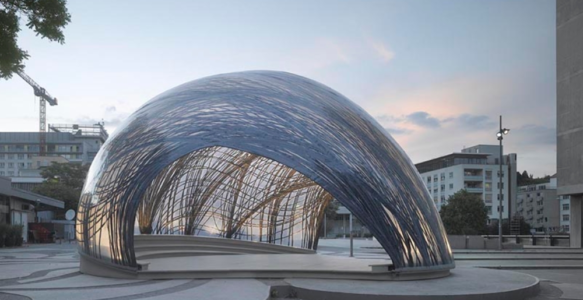
Credit: © ICD/ITKE University of Stuttgart
In the realm of architectural innovation, the Research Pavilion at the University of Stuttgart stands as a testament to the influence of the natural world on groundbreaking construction methodologies. Developed by the Institute for Computational Design and Construction (ICD) and the Institute of Building Structures and Structural Design (ITKE), this project highlights the potential of integrating biomimicry into modern architectural practices.
The Pavilion was the brainchild of a team of architects and engineers led by Professors Achim Menges and Jan Knippers. Menges, an expert in architecture and computational design, and Knippers, a specialist in structural design, pooled their expertise to push the boundaries of traditional construction through the lens of biomimicry.
The Pavilion’s design draws heavily from the natural world, particularly the efficient structural principles observed in sea urchin skeletons and other marine organisms. These creatures demonstrate an optimal use of materials to create robust structures with minimal mass. By emulating these natural efficiencies, the team employed advanced computational design and fabrication technologies to transform biological principles into architectural solutions.

Diving Bell Water Spider (Agyroneda aquatica) reinforcing an air bubble from the inside © ICD/ITKE University of Stuttgart
Central to the Pavilion’s construction was the adoption of robotic fabrication techniques alongside traditional materials such as wood. This project featured a pioneering robotic process to wind composite materials into a doubly curved structure, reducing material waste and enhancing structural integrity.
This approach resulted in a lightweight yet durable structure that mirrors the functionality and aesthetics of natural forms. The Pavilion is both a scientific breakthrough and a piece of art, showcasing the potential of nature-inspired designs.


The Research Pavilion underscores the role of sustainable construction practices in modern architecture. By optimizing material use and minimizing waste, the project sets a new benchmark for environmentally conscious construction, demonstrating how biomimetic design can lead to more sustainable building solutions.
The Research Pavilion in Stuttgart is more than an architectural endeavor; it is a beacon of how natural designs can foster superior building practices. It serves as a powerful model for future constructions, showing that merging biomimicry with architectural design can enhance efficiency, sustainability, and aesthetic value. The collaboration at the University of Stuttgart paves the way for a new era of construction where nature and technology converge to produce structures that are both functional and in harmony with the environment.
